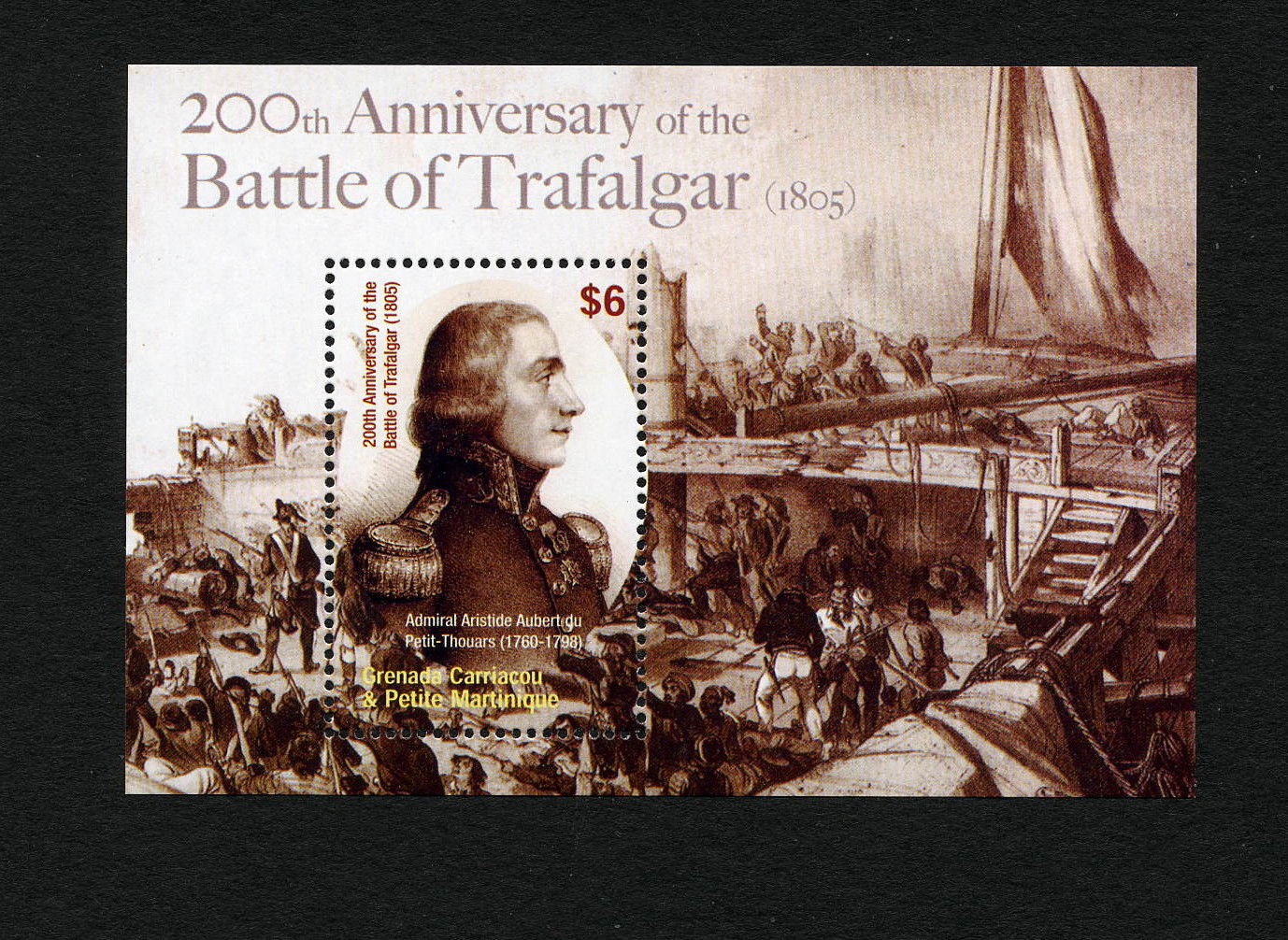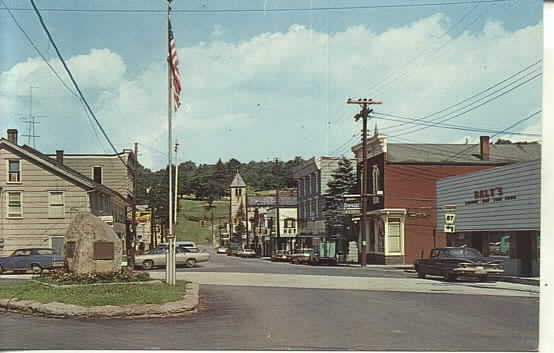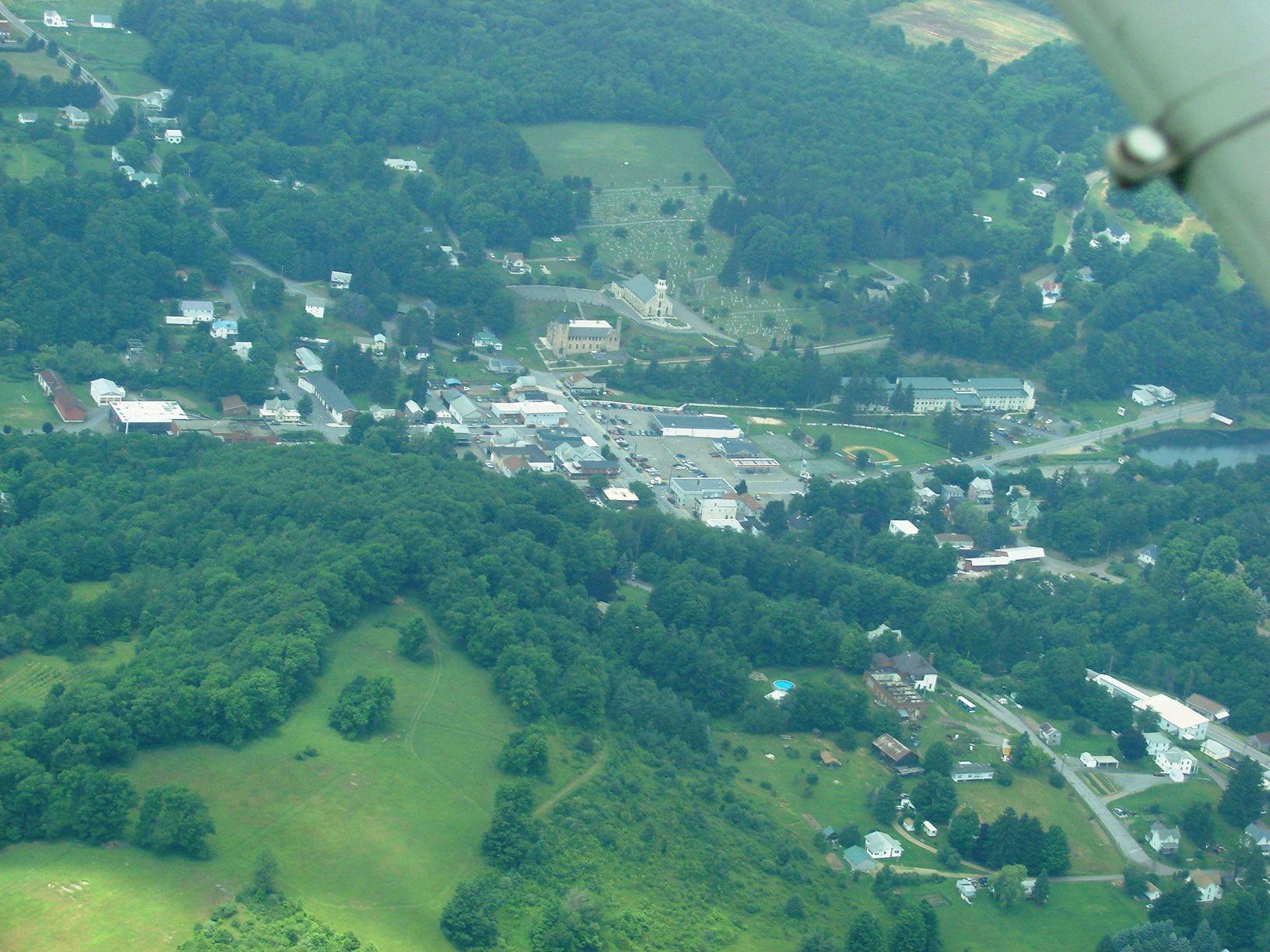| We are indebted for this historical review to Professor Frank Snyder, born in 1926, son of Mildred and Abraham Snyder. He is a Dushore historian and avid railroad buff, collecting old train schedules
for Sullivan County (from 1940 and back) and wonderful pictures of trains and stations from Sullivan County in
that era. Frank, an avid historian of Dushore and intimately involved with the preservation and recognition of the origin of the town's
French origins, can be reached at Frank Snyder.
In October 2005, Bill Mahaffey, a philatelist [i.e., stamp collector] drew our attention to the anniversary of the Battle of Trafalgar, the
great naval engagement of 1805 when Admiral Horatio Nelson defeated the French fleet off Spain. Among other international recognitions of this
event was the issuance of a stamp by the tri-island Caribbean nation of Grenada, Carriacou and Petite Martinique honoring Aristide-Aubert
Dupetit-Thouars. That stamp is reproduced below. Anyone interested in other stamps or other facets of the life of Aristide can contact Bill at wmahaffey@udata.com.

Sullivan Terrace
Dushore, PA
Approximate Location of "Frenchman's Spring"
Where Aristide-Aubert Dupetit-Thouars Spent the Winter of
1794-5
Later the Location of the Town of Dushore
November 2004
Photo by Mike Krause
Aristide-Aubert Dupetit-Thouars
Aristide-Aubert Dupetit-Thouars was born in 1760 at Chateau de Boumois, on the right bank of the
Loire seven kilometers northwest of Saumur. He entered the French Navy in 1778, participated in the battle of
Ouessant and the taking of Saint-Louis-du-Senegal, and served in the Caribbean with Admiral de Guichen in his three
battles against Admiral Rodney (1780). Dupetit-Thouars, at the battle of the Nile (Aboukir) on 1 August 1798,
was a Capitaine de Vaisseau in command of the 80-gun ship-of-the-line Tonnant ("Thunderer").
During the battle, Tonnant captured one British ship and destroyed another; but, in the end, Tonnant
was dismasted and Dupetit-Thouars, who was badly wounded, refused to surrender. He had the French flag nailed to
the mast, and, at his death, his body (as he had requested) was thrown overboard to avoid being taken by the British.
Commemorating his heroic death, there is at Boumois a spirited statue of a defiant Aristide Dupetit-Thouars.
In the middle of Dupetit-Thouars's naval career, his life took an unexpected turn. The great
French explorer La Perouse had crisscrossed the Pacific Ocean (1785-88), and had sent his journals to France
from Botany Bay, on the eastern coast of what is now Australia. He then set out once more, never to be heard
from again. In January 1791, the French Societe D'Histoire Naturelle asked the National Assembly to organize an
expedition to search for him. Aristide Dupetit-Thouars was among those who began organizing expeditions to search
for the lost explorer (possibly because he had served with La Perouse during the War of American Independence).
Dupetit-Thouars has been characterized by an historian as "a romantic, burning to distinguish himself in some great
enterprise and willing to make real sacrifices to finance his expedition." Dupetit-Thouars launched an appeal for funds for the voyage; he sold the greater part of his personal
property, and persuaded the Assembly to vote him a grant of 10,000 livres. When all this proved to be
insufficient, he mortgaged his future, obtaining two years' of his navy pay in advance.
He departed France in command of the Diligent on 22 August 1792 intending to enter
the Pacific by rounding Cape Horn. Near Cape Verde he rescued forty marooned Portuguese sailors, but, during the
Atlantic crossing, his overcrowded and ill-provisioned ship was infected by an epidemic. By the time Diligent
put in for medical assistance at Fernando de Noronha, several hundred miles off the coast of Brazil,
nearly a third of his crew had died, and the remainder were suffering from fever. The governor of the island,
flatly refusing to believe Dupetit-Thouars' claims, seized the ship and its crew, and sent them to Pernambuco on the
Brazilian coast, and eventually to Lisbon, where Dupetit-Thouars and his crew were imprisoned.
When Dupetit-Thouars was released in August 1793, he set out for Philadelphia. There he joined
with other emigres from France, as well as French refugees from Santo Domingo, that were setting out to found a
French settlement in northeastern Pennsylvania, as part of an enterprise promoted by the financier Robert Morris.
The main site called Azilum consisted of 1600 acres of bottom land in a bend of the north branch of the Susquehanna
River midway between Wylausing and Towanda. Three hundred acres were laid out as a town plot of over four
hundred lots. In 1794, Dupetit-Thouars worked for the enterprise as supervisor of the construction of about
thirty houses. Among the buildings was one (84 feet by 60 feet) referred to as La Grande Maison, and later
as "The Queen's House", in the hope that Marie Antoinette and her children would somehow escape from France and
come to occupy it.
In payment for his services to the Azilum enterprise, Dupetit-Thouars was given a three-hundred-acre
piece of land nearly twenty miles south of Azilum. He build a log house, twelve feet square, and spent the winter of
1794-95 there, on the Little Loyalsock Creek, at what is now the town of Dushore. As a boy, Dupetit-Thouars had been
greatly attracted by the situation of Robinson Crusoe, so he was delighted with the prospect of living on the
land by his own ingenuity and following some of the principles of Rousseau. He built a cabin and had intended to
invite his two sisters in France to join him there, but, although he did do some clearing, he did not stay permanently.
Except during the dead of winter, he would walk the twenty miles to Azilum on weekends. He also took longer walks:
one to Philadelphia in search of news about his sisters, and two to upper New York State.
In early 1798, Dupetit-Thouars left Pennsylvania and returned to France to serve once again as a
French naval officer, this time in Napoleon's navy. His naval career and his life ended later that same year at
the Battle of Aboukir.

Stamp Commemorating the Battle of Trafalgar in 1805
Featuring Admiral Aristide-Aubert Dupetit-Thouars
2005
Photo by Bill Mahaffey
Stamp issued by the government of Grenada, Carriacou and Petit Martinique
Editor's Note: Along with his pictue of the stamp, Bill Mahaffey sent the following commentary:
Our recent exchange of e-mails prompted me to brush up on the good Admiral's history. His connection with the Battle of Trafalgar is very vague, indeed. He just was once associated with officers and ships (the Tonnant, for example) which were later involved with the big Battle. He obviously died before the Battle of Trafalgar.
A number of the countries not directly involved with the Battle of Trafalgar have pictured on their stamps some fairly far-fetched scenes to connect with the Battle. Admiral Lord Horatio Nelson also fought with his fleet in the Caribbean earlier and several Caribbean countries pounced on that. The HMS Pickle, an important warship in the Battle of Trafalgar, was built in Bermuda. So Bermuda's stamps depict the HMS Pickle's construction there.
Other countries had no conceivable connection with the Battle. Some, such as the British Indian Ocean Territories, were just loyal members of the Commonwealth and commemorated the Battle for that reason. The crippled flagship HMS Victory was towed to Gibraltar after the Battle and Gibraltar depicts that event. They also depict the flag-draped barrel of rum (or brandy) that Admiral Nelson's body was allegedly preserved in to be shipped home for his funeral [he was killed in the battle by a French sharpshooter]. And then there we have Liberia and Sierra Leone. They will apparently issue stamps for anything for the income they generate.
The Admiral's story was complex, and, thanks to you and Frank Snyder, I know much more of it. Many lesser known men (and women... Nelson's mistress and their daughter, Horatia, for example) have been depicted on stamps. I am doing my best to dig up histories on them.
The "country" which issued the stamp shown here is "Grenada Carriacou & Petite Martinique." This 2"x3" miniature sheet is the high value of the set of five from that "country. The other four are regular stamps (not miniature sheets) depicting other Trafalgar men of fame. Should anyone want an actual set of the stamps (1 MS + 4 stamps), they are still available.
Some of the island countries of the West Indies are known for putting out stamps from nearly uninhabited islands. This is one. But yes, it's legitimate.
I printed out your history of the good Admiral's wanderings through PA for my Trafalgar package. 33 countries have issued at least 230 stamps commemorating the 200th anniversary of the Battle of Trafalgar.
Bill Mahaffey
October 30, 2005
During the second decade of the nineteenth century, a toll road--the Susquehanna & Tioga
Turnpike--was built from Berwick on the north branch of the Susquehanna River to Newtown, near Elmira, on the Tioga
(now the Chemung) River, a distance of about eighty-five miles. A later modification of this road crossed the
Little Loyalsock Creek near the site of Dupetit-Thouars' 1794 cabin. The land along the route of the turnpike was
initially settled by the men who had worked to build the road; much of their pay was in the form of land along
the right of way. Many of the settlers had been attracted by the huge hemlocks that grew in that vicinity, so
they expected that when the land was cleared, it would be very fertile.
In 1859, the settlement at the turnpike's crossing of the Little Loyalsock Creek was
incorporated as a borough, and the names of several early settlers were considered for the town's name.
The citizens resolved the issue by naming the town after its original settler, Dupetit-Thouars, but chose to
modify his actual French name to "Dushore," because the older German settlers could pronounce it better.
The Sullivan County Democrat
June 3, 1859
Dushore- This flourishing little village, in Cherry Township, was
incorporated into a boro' at the last session of our court. Dushore is a
business place, and is deserving of more attention than has been shown it.
Heretofore by its citizens, and now that it has become a borough, the
neessary improvements will probably be made. Roads, sidewalks, and bridges
are the three things necessary to make it clean and comforable. The first
election for borough officers will be held on the first Monday of August.
In 1960, on the bicentenary of Dupetit-Thouars' birth, the Borough of Dushore named the
town's park "DuThouar's Park" in his honor; and for the bicentenary fete to be held at his birthplace, they
sent a token gift of a bottle of locally-blown glass filled with maple syrup (representing local produce)
to be added to other mementoes at Boumois, France. Today, the collection is at least partially a museum to Aristide Dupetit-Thouars.
The Dupetit-Thouars family has given France a number of daring sailors: three admirals,
two captains, and two lieutenants having made the name illustrious. Since 1799, six French warships have
carried that name: a gunboat, a brig, a cruiser, an armored cruiser, a submarine, and a destroyer.
The destroyer (escorteur d'escadre) Dupetit-Thouars was commissioned in 1956, and was later
fitted with guided missiles. It served in the French Navy until decommissioned in 1990. When the ship made a
port call at Washington, DC, in 1964, the Dushore Lions Club sent a plaque to the ship to remind the crew
that a small town in northeastern Pennsylvania is--like the ship--named for an heroic French naval officer.
Sources
Dupetit-Thouars, Aristide-Aubert. Vie, Lettres, Voyages, Memoirs et Opuscules D'Aristide-Aubert Du Petit-Thouars. Paris: Chez Mm. Denta, Delaunoy, Pelicier at Petit, 1800.
Ingham, Thomas J. History of Sullivan County, Pennsylvania. Chicago: Lewis Publishing,
1899.
Dupetit-Thouars, Admiral Bergasse, ed. Aristide Aubert du Petit-Thouars, Heros d'Aboukir,
Lettres at Documents Inedits. Paris: Librarie Plon, 1937.
Jordan, Mildred. Asylum for the Queen. [A novel in which Aristide Dupetit-Thouars
is portrayed as a philosophic voice.] New York: Alfred P. Knopf, 1948.
Murray, Elsie. Azilum: French Refugee Colony of 1793. Athens, PA: Tioga Point Museum, 1950.
Asylum for a Queen. Historic Pennsylvania Leaflet No. 11. Harrisburg, PA: Pennsylvania
Historical and Museum Commission, 1957
Carmer, Carl. "La Riviere Lointaine," Chapter 17, The Susquehanna. New York:
Holt, Rinehart and Winston, 1955.
Borough of Dushore Centennial, 1859-1959. Souvenir Program. 1959.
Warner, Oliver. The Battle of the Nile. London: William Clowes and Sons, 1960.
Les Chateaux De La Loire. Clermont-Ferrand, France: Michelin Guides Verts, 1964.
Dunmore, John. French Explorers in the Pacific. Oxford: Clarendon Press, 1965.

Dushore, PA
Early 1960s
Undated Photo
However, Bettyann Sick Goodyear, a lifelong resident of Dushore, guesses a date of the early 1960's: "The Daly bar was bought by Jay Davis three days before the 1972 Hurrican Agnes flood. In the 1959 Centennial book for Dushore Boro, J.A. Daly had an ad for 104 Railroad St. and 126 M. Street. He used to have a small bar behind
the front building. The Daly building on Main Street used to have candy, sundaes,and a
lunch shop run by Gerard Murray, who also had an ad in the Centennial book. The building may have
been changing hands then. I really believe the car sitting in front of Daly's is a 1960 Chevy. The 1959 Chevy had a more pointed wing above the trunk. The blue car on the left of the monument could be a 1961 Lincoln, but I am not
sure."
Photo Posted on eBay in October 2003
Copyright © 2002 Robert
E. Sweeney and individual Contributors. All Rights Reserved. Prior written
permission is required from Robert E. Sweeney and individual Contributors before
this material can be printed or otherwise copied, displayed or distributed
in any form. This
is a FREE genealogy site sponsored through PAGenWeb and can be reached directly
at ~Sullivan County Genealogy Project (http://www.rootsweb.com/~pasulliv)
|

